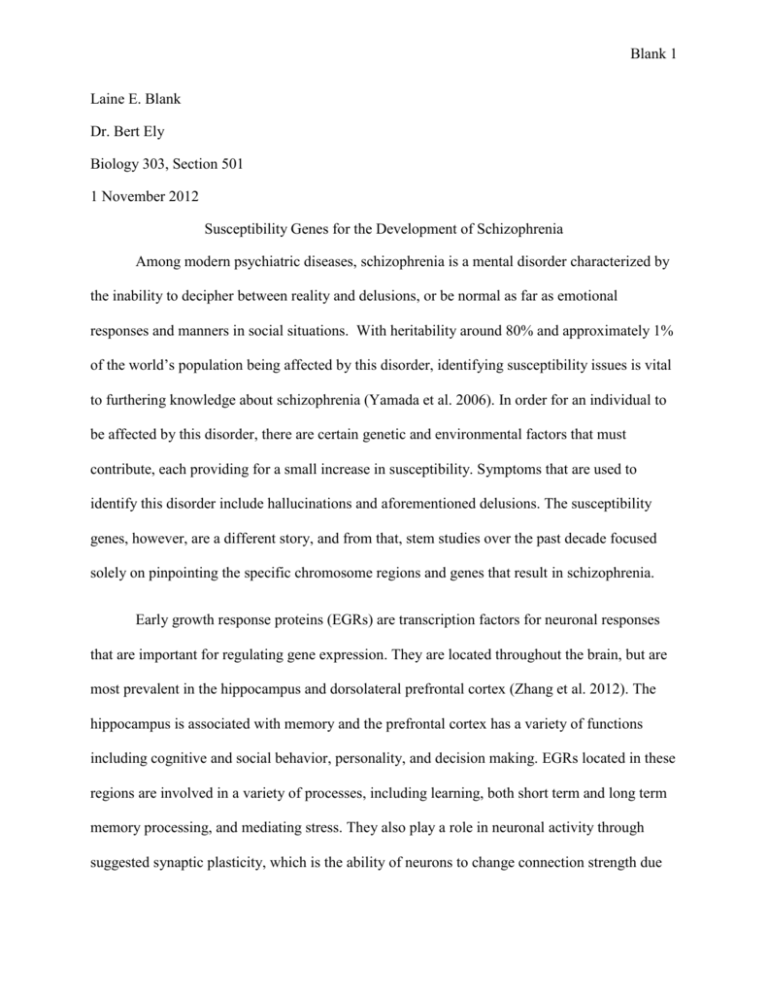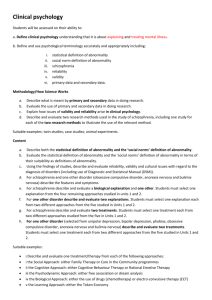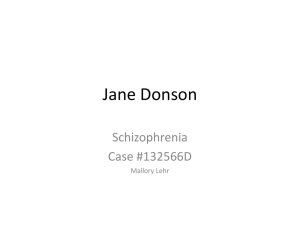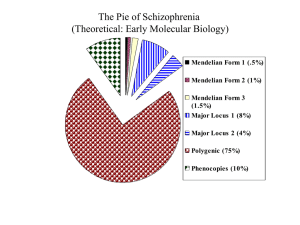Schizophrenia
advertisement

Blank 1 Laine E. Blank Dr. Bert Ely Biology 303, Section 501 1 November 2012 Susceptibility Genes for the Development of Schizophrenia Among modern psychiatric diseases, schizophrenia is a mental disorder characterized by the inability to decipher between reality and delusions, or be normal as far as emotional responses and manners in social situations. With heritability around 80% and approximately 1% of the world’s population being affected by this disorder, identifying susceptibility issues is vital to furthering knowledge about schizophrenia (Yamada et al. 2006). In order for an individual to be affected by this disorder, there are certain genetic and environmental factors that must contribute, each providing for a small increase in susceptibility. Symptoms that are used to identify this disorder include hallucinations and aforementioned delusions. The susceptibility genes, however, are a different story, and from that, stem studies over the past decade focused solely on pinpointing the specific chromosome regions and genes that result in schizophrenia. Early growth response proteins (EGRs) are transcription factors for neuronal responses that are important for regulating gene expression. They are located throughout the brain, but are most prevalent in the hippocampus and dorsolateral prefrontal cortex (Zhang et al. 2012). The hippocampus is associated with memory and the prefrontal cortex has a variety of functions including cognitive and social behavior, personality, and decision making. EGRs located in these regions are involved in a variety of processes, including learning, both short term and long term memory processing, and mediating stress. They also play a role in neuronal activity through suggested synaptic plasticity, which is the ability of neurons to change connection strength due Blank 2 to certain signal transmissions. Previous studies have shown that various stimuli activate EGRs in the brain, some of these stimuli are environmental triggers, antipsychotics, and seizures (Kim et al. 2010). One of the early growth proteins, EGR3, is necessary for normal brain development and serves as a transcription factor for the calcineurin signaling pathway. Calcineurin is a protein phosphatase that, along with other proteins, regulates dopaminergic, glutamatergic, and other signaling pathways between neurons (Yamada et al. 2006). It has been observed that alterations of these pathways have an effect on schizophrenia. The studies that follow focus attention on determining the strength of association between the calcineurin pathway and genes on chromosome 8p that are thought to be associated with the development of schizophrenia amongst East Asian populations. The EGR3 gene and another calcineurin related gene, PPP3CC, are both located on chromosome 8p. With these two genes being located in close proximity to each other and both being related to the calcineurin pathway, some of the studies that follow aim to find if there is an association, between the two in regards to their contribution to the development of schizophrenia. The first study conducted by Yamada et al. (2006) analyzed SNPs, or single nucleotide polymorphisms, in Japanese individuals. Previous associations between PPP3CC and schizophrenia within populations of both the United States and South Africa sparked the interest of finding linkage between the disorder and SNPs of adjacent genes, including EGR3. Comparisons were made between schizophrenic patients and control subjects with regards to allele distributions, genotype distributions, and haplotype frequencies to determine which of the 84 SNPs being analyzed showed positive association with schizophrenia. The SNPs were analyzed in 124 different Japanese schizophrenia pedigrees, or family lineages, of schizophrenia made up of 374 individuals total. Of those SNPs being analyzed, the ones associated with Blank 3 PPP3CC are rs1049437 and rs2449348, and with EGR3 are rs35201266 and rs3750192. Using pedigree analysis, Yamada et al. (2006) determined that the significant association between EGR3 and schizophrenia increased in families that did not inherit the risk allele on PPP3CC. To take that further, the specific genomic region on chromosome 8p that plays host to both of the above genes was analyzed by genotyping 49 different SNP markers, and it was revealed that PPP3CC and EGR3 are located on different linkage disequilibrium islands on the genome (Yamada et al. 2006). Therefore, despite their close proximity on chromosome 8p, the results of this pedigree analysis support the idea that EGR3 and PPP3CC each have independent risks for the inheritance of schizophrenia. As previously stated, both of these genes contribute to the calcineurin pathway. From the results obtained by Yamada et al. (2006), the only thing that can be concluded is that the two genes affect signal transduction of the pathway that leads to neuronal responses. More studies would have to be done to discover the specific molecular basis of this relationship between the presence of these two genes and the calcineurin pathway (Yamada et al. 2006). Yamada et al. (2006) also included an analysis of postmortem brains of schizophrenic patients to determine the mRNA levels associated with both of the previously named genes in the postmortem hippocampus and dorsolateral prefrontal cortex. Results from the RNA that was obtained from these two regions of the brain showed that EGR3 was downregulated in the dorsolateral prefrontal cortex in schizophrenic patients, while the PPP3CC levels were down-regulated in the hippocampus of those with schizophrenia (Yamada et al. 2006). Since the hippocampus is involved with memories and the prefrontal cortex is associated with behavior, personality, and decision making, the down-regulation in these regions could contribute to the symptoms that are characteristic of schizophrenia. Overall, this study provided Blank 4 evidence for the association between EGR3 and PPP3CC and increased risk for schizophrenia and determined that the two loci provide this increased risk independent of each other. The apparent association between the identified genes sparked interest amongst other scientists, including Kim et al. (2010) who aimed to determine whether EGR3 is a susceptibility gene for schizophrenia. To include another variation, they used a population of different ethnicity. The population examined for this study was Korean, with 350 controls and 244 patients with schizophrenia. After the analysis of EGR3 genes of both the controls and those who have schizophrenia, this study verified what was previously proven in the study conducted by Yamada et al. (2006). For SNP rs35201266, the “T” allele was overrepresented in schizophrenic patients, which is an allele that shows correspondence to a particular mutation that negatively affects the transcriptional activity of EGR3 thus leading to the reduced expression of EGR3 in the brains of schizophrenic patients (Kim et al. 2010). Just as was proven previously, there is a significant association between the EGR3 SNP rs35201266 and the development of schizophrenia (OR=0.697, P=0.0073). It had also been suggested that the EGR3 region of chromosome 8p is associated with bipolar disorder (Mansour et al., 2009). The specific SNP that has been discovered to be associated with bipolar disorder, rs1996147, wasn’t a part of the study conducted by Kim et al. (2010), however it is located in such close proximity to EGR3 SNP rs3501266 that it raises the question of any possible linkage. The researchers suggested that further testing to identify the potential association between the SNPs on EGR3 for schizophrenia and bipolar disorder would be worthwhile. Despite the fact that the previous study found evidence for the association between PPP3CC and EGR3 on chromosome 8p and their contributions to the development of schizophrenia, there were two studies that failed to observe these associations (Liu et al. 2010, Blank 5 Kyogoku et al. 2011). The first study conducted was by Liu et al. (2010) on a Chinese population with 1025 control individuals and 1019 schizophrenic patients. Twelve SNPs were analyzed from the EGR family, including EGR3 rs35201266, and the genotype frequencies were determined to see if there were associations between those subjects with schizophrenia and those without the disorder. As a whole, there was no significant association with 11 EGR1, EGR2, EGR3, and EGR4 loci and schizophrenia. However, the genotype frequencies for a twelfth locus, EGR3 SNP rs35201266, were not in Hardy-Weinberg Equilibrium, so this locus was not analyzed further. The P values for the genotypes of the 11 SNPs that were in Hardy-Weinberg Equilibrium ranged from 0.267 to 0.791. A separate investigation was conducted by Kyogoku et al. (2011) involving studies to test the association between EGR3 and PPP3CC and schizophrenia among 337 Japanese patients and 369 controls. EGR3 SNP rs3750192 and PPP3CC SNPs rs10108011 and rs2461491 were genotyped, and it was found that the EGR3 SNP was not in linkage disequilibrium with either of the PPP3CC SNPs (rs10108011: OR=1.01, P=0.96; rs2461491: OR=1.21, P=0.14). The discrepancy with the results and those from other studies could be due to small sample size, the choice of SNPs, or differences in regards to the genetic backgrounds in the populations. The most recent study of the association of the EGR3 gene and schizophrenia was conducted by Zhang et al. (2012) with a Chinese population sample consisting of 470 schizophrenic patients and 480 control subjects. Similar to the previous studies, genotype and allele frequencies were determined for primary analysis. There was a significant association shown between the frequencies of EGR3 SNP rs35201266 alleles and the occurrence of schizophrenia between those with schizophrenia and the control subjects (P=0.009 for a single allele and P=0.016 for two alleles). A limitation of their study, however, was moderate sample Blank 6 size. After they conducted primary analysis, Zhang et al. (2012) combined the results from several studies (Table 5) and conducted a meta-analysis to determine the association between EGR3 SNP rs35201266 and schizophrenia. They found a significant difference (P=0.0078). Thus, the meta-analysis demonstrates that EGR3 rs35201266 does have an effect on the development and inheritance of schizophrenia amongst East Asian populations (Zhang et al. 2012). In summary, the association between the PPP33CC and EGR3 alleles and the development of schizophrenia is evident. Even though alleles in both genes contribute to the development of the mental disorder, they appear to act independently of one another. Also, the expression of both genes is down-regulated in their respective areas of the brain in Asian populations. Additional studies need to be conducted in order to determine if this phenomenon occurs in other ethnicities outside of East Asia. All in all, the studies of genes on chromosome 8p and their association with schizophrenia are putting the scientific community well on their way to better understanding population susceptibility to this prevalent mental disorder. Blank 7 Works Cited Kim S.H., Song J.Y., Joo E.J., Lee K.Y., Ahn Y.M., Kim S.Y. 2010. EGR3 as a potential susceptibility gene for schizophrenia in Korea. American Journal of Medical Genetics 153B:1355-1360. Kyogoku C., Yanagi M., Nishimura K., Sugiyama D., Morinobu A., Fukutake M., et al. 2011. Association of calcineurin A gamma subunit (PPP3CC) and early growth response 3 (EGR3) gene polymorphisms with susceptibility to schizophrenia in a Japanese population. Psychiatry Research 185:16-19. Liu B., Xhang J., Wang L., Xing-wang L., Wang Y., Ji J., et al. 2010. No association between EGR gene family polymorphisms and schizophrenia in the Chinese population. Progress in Neuro-Psychopharmacology & Biological Psychiatry 34:506-509. Mansour H., Talkowski M., Wood J., Chowdari K., McClain L., Prasad K., et al. 2009. Association study of 21 circadian genes with bipolar I disorder, schizoaffective disorder, and schizophrenia. Bipolar Disorder 11:701–710. Yamada K., Gerber D., Iwayama Y., Ohnishi T., Ohba H., Toyota T., et al. 2006. Genetic analysis of the calcineurin pathway identifies members of the EGR gene family, specifically EGR3 as potential susceptibility candidate in schizophrenia. PNAS 104:2815-2820. Zhang R., Lu S., Meng L., Min Z., Tian J., Valenzela R., et al. 2012. Genetic evidence for the association between the early growth response 3 (EGR3) gene and schizophrenia. PLoS One 7:1-8.








